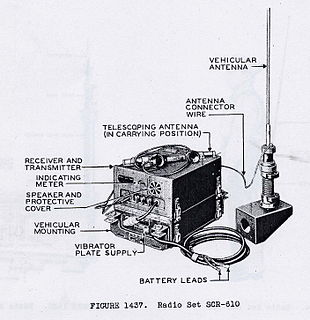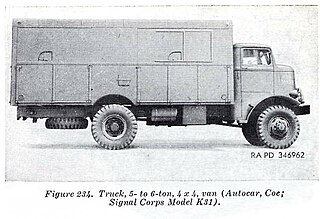Related Research Articles

The M19 Tank Transporter was a heavy tank transporter system used in World War II and into the 1950s. It consisted of a 12-ton 6x4 M20 Diamond T Model 980 truck and companion 12-wheel M9 trailer.

The SCR-784 was a radar set used by the U.S. Army designed to be an amphibious version of the SCR-584, to control the fire of anti-aircraft batteries, and mounted on a searchlight trailer called a K-84. The set was used to guide the flare plane over the target.
The SCR-197 was a ground mobile high frequency radio station used by the U.S. Army Signal Corps prior to and during World War II, notably the Battle of Wake Island in 1941.
The K-38 splicer's trailer was used in World War II for carrying telephone cable splicers tools in the field.

The SCR-277 was a mobile, trailer mounted radio range set for radio guidance of aircraft. It was standardized by the U.S. Army in June 1941.

The Jeep trailer was a small, 1⁄4 short ton payload rated, cargo trailer, designed in World War II, tailored to be towed by 1/4-ton U.S. Army jeeps. Versions of the quarter-ton jeep trailer remained in military use, by the U.S. or other countries, at least through to the 1990s.

Ben Hur trailer was the nickname of the World War II U.S. Army Trailer, 1-ton payload, 2-wheel, cargo, and the Trailer, 1-ton payload, 2-wheel, water tank, 250 gallon. Specialized variants were also manufactured.

The K-36 trailer was a telephone pole hauling trailer used by the U.S. Army during and after World War II.
The K-34 trailer was used by the U.S. Army Signal Corps to house electronic equipment, during and after World War II.
The K-35 trailer was a house trailer used by the U.S. Army Signal Corps during and after World War II.
The K-55 trailer, manufactured by the A. J. Miller and Oneonta Linn Corp, was a house trailer used by the U.S. Army Signal Corps during and after World War II.
The K-72 trailer, manufactured by the A. J. Miller, was a house trailer used by the U.S. Army Signal Corps during and after World War II.

The Dodge WC-54, Ambulance, 3⁄4-ton, 4 x 4,, was the main military ambulance variant of the prolific Dodge WC series of light 4×4 trucks, developed during World War II. Built from 1942 until 1945, they served as the U.S. Army's main dedicated ambulance, with many also serving in the Korean War, in the U.S. Army Medical Corps, some used as late as 1953; and others serving as late as the 1960s in the armies of some European countries.

The K-50 telephone repair trucks were used by the U.S. Army Signal Corps, during and after World War II, for the installation and repair of hard telephone lines, primarily in territories liberated from Nazi Germany by the Allied forces.
The radio set AN/CRN-2 was an air transportable glide path transmitter used by the Army Air Force during and after World War II, the set was standardized on 5 February 1944. and was an upgrade of SCR-592.

The SCR-610 was a Signal Corps Radio used by the U.S. Army during and after World War II, for short range ground communications, it was standardized 29 Sept. 1941,

The Autocar Model U8144T, officially "5- to 6-Ton, 4×4, Ponton Tractor Truck", was the largest, and most heavy-duty, of a family of heavy four-wheel drive trucks developed for, and deployed primarily with, the United States Army in World War II. They were of a "cab over engine" design, and produced by the Autocar Company from 1941 to 1945 with 2,711 being built.

The K-31 truck, a US Signal Corps designation for an Autocar U8144 truck with York-Hoover van body, was used as the power truck for the SCR-270, an early warning radar of World War II. The power it delivered to the radar came from a PE-74 generator. 2) 3) 4) Similar vehicles were the K-30 and K-62 or K-62-A, all three operating trucks for the SCR-270. K-31 differed in cubic feet and overall height from K-30 and K-62. The K-62 AND K-62A were the successors of both the K-30 and K-31. Note the difference in form of the wheel arch of the van body between the depicted vehicles that shows that there must have been successive models from York-Hoover. The third image in het gallery shows that the two panels at each side were folded up when the vehicles where operated, while the panels at the back where two halves that were folded up and down respectively.

The K-30 truck, a US Signal Corps designation for an Autocar U8144 truck with York-Hoover van body, was used as the Operating Truck for the SCR-270, an early-warning radar of World War II. 2) 3) 4) Similar vehicles were the K-31 power truck for the SCR-270 early warning radar and K-62 or K-62-A, both operating trucks also for the SCR-270. K-30 and the similar K-62(-A) differed in cubic feet and overall height from the K-31. On the accompanying image in the infobox can be seen, that the K-30 beside in cubic feet and overall height differed from the K-31 in having a window on the right side of the van body. The panels at the back and at both sides were formed by two halves, that were folded up and down respectively. This truck contains a high-power radio transmitter, a cooling system for the transmitter tubes, two cathode-ray oscilloscopes, two superheterodyne receivers, a vacuum-tube keyer, a plotting table, and containers for spare parts and tubes.
References
- TM 9-2800 Standard Military Motor Vehicles. dated 1 sept. 1943
- TM 9-2800 Military vehicles dated Oct. 1947:https://www.scribd.com/doc/188375301/TM-9-2800-1947
- TM 11-227 Signal Communication Directory. dated 10 April 1944
- TM 11-487 Electrical Communication systems Equipment. dated 2 Oct. 1944